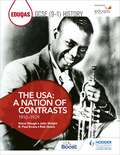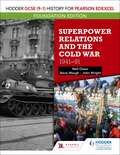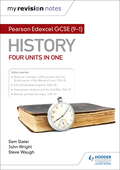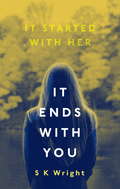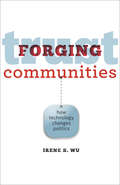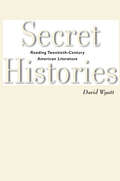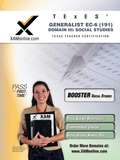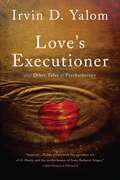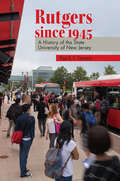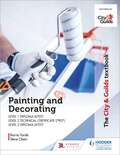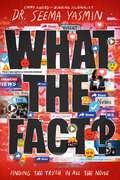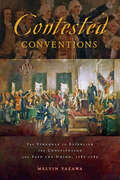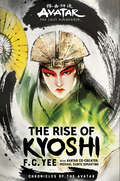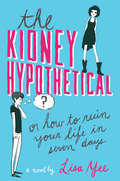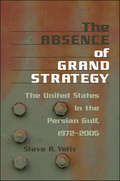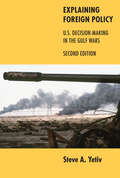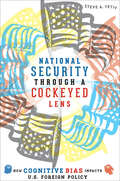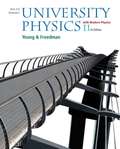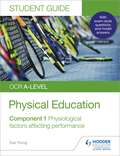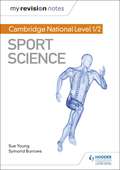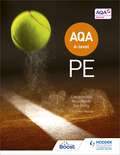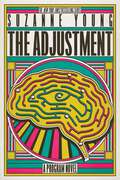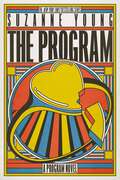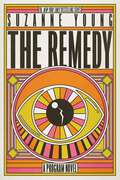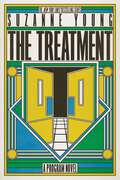- Table View
- List View
Eduqas GCSE (9-1) History The USA (9-1) History The USA (9-1) History The USA (9-1) History The USA (9-1) History The USA (9-1) History The USA (9-1) History The USA (9-1) History The USA: A Nation of Contrasts 1910-1929: A Nation Of Contrasts 1910-1929
by John Wright Steve Waugh R. Paul Evans Rob QuinnExam board: EduqasLevel: GCSESubject: HistoryFirst teaching: September 2016First exams: June 2018Endorsed by EduqasHelp every student to achieve their best, with bespoke support for Eduqas GCSE History from the leading History publisher for secondary schools.Structured around the key questions in the 2016 specification, this book:> Develops in-depth subject knowledge through clear and detailed coverage of the important issues, events and concepts> Builds students' historical skills and thinking as they progress through a range of activities and questions> Prepares students for assessment by providing step-by-step guidance and model answers for each question type> Increases understanding and enjoyment by including a rich variety of source material that brings the period to life
Hodder GCSE (9–1) History for Pearson Edexcel Foundation Edition: Superpower Relations and the Cold War 1941–91
by John Wright Steve Waugh Neil OwenExam board: Pearson EdexcelLevel: GCSE (9-1)Subject: HistoryFirst teaching: September 2016First exams: Summer 2018Help more students access the content for Pearson Edexcel GCSE History with this Foundation Edition, containing bespoke text and activities to support students working up to Grade 5.Covering Superpower relations and the Cold War, 1941-91, this book:- Follows the same structure and page numbers as the mainstream textbook for effective co-teaching in the same class- Simplifies and reduces the text on each page, focusing on the essential knowledge that students need and using clear diagrams to explain more challenging concepts- Uses carefully-controlled vocabulary throughout, ensuring that the reading level is appropriate for all students, including those with lower literacy levels or English as an additional language (EAL)- Develops students' knowledge, understanding and skills through accessible and achievable tasks- Provides step-by-step guidance on how to answer exam questions and target a Grade 5, building students' confidence as they revise and practise for their exams- Includes definitions of 'useful words' and 'history words' at the start of each key topic to boost students' vocabulary
My Revision Notes: Pearson Edexcel GCSE (My Revision Notes Ser.)
by John Wright Steve Waugh Sam SlaterExam board: Pearson EdexcelLevel: GCSE (9-1)Subject: HistoryFirst teaching: September 2016First exams: Summer 2018Target success in Pearson Edexcel GCSE (9-1) History with this proven formula for effective, structured revision. Key content coverage is combined with exam-style questions, revision tasks and practical tips to create a revision guide that students can rely on to review, strengthen and test their knowledge.With My Revision Notes every student can:- Plan and manage a successful revision programme using the topic-by-topic planner- Enjoy an interactive approach to revision, with clear topic summaries that consolidate knowledge and related activities that put the content into context- Build, practise and enhance exam skills by progressing through activities set at different levels- Improve exam technique through exam-style questions and sample answers with commentary- Get exam ready with extra quick quizzes and answers to the activities available onlineThis revision guide covers the following options:- Medicine in Britain c1250-present and The British sector of the Western Front, 1914-18- Early Elizabethan England, 1558-88- Superpower relations and the Cold War, 1941-91- Weimar and Nazi Germany, 1918-39
It Ends With You
by S. K. Wright'A darkly clever teen murder mystery [...] that succeeds in undermining everything you've come to believe and trust. S K Wright pulls off a difficult trick with apparent ease' Crime ReviewIf I'd told the truth, it would have been fiction.Everyone loves Eva. Beautiful, bright, fun, generous - she's perfect. So when her body is found in a ditch in the local woods the only thing anyone wants to know is: Who could have done this?It has to be Luke, her boyfriend. He has the motive, the means, the opportunity and he's no stranger to the police. Even though the picture is incomplete, the pieces fit. But as time passes, stories change.Who could have done this? You decide.It Ends With You is clever and compulsive. It challenges preconceptions, makes you second-guess yourself with each chapter, and it holds an uncomfortable mirror up to the way societies and systems treat outsiders.
Forging Trust Communities: How Technology Changes Politics
by Irene S. WuTwenty historical case studies reveal how communication technology allows people to trust one another while mobilizing around a shared cause.Bloggers in India used social media and wikis to broadcast news and bring humanitarian aid to tsunami victims in South Asia. Terrorist groups like ISIS pour out messages and recruit new members on websites. The Internet is the new public square, bringing to politics a platform on which to create community at both the grassroots and bureaucratic level. Drawing on historical and contemporary case studies from more than ten countries, Irene S. Wu’s Forging Trust Communities argues that the Internet, and the technologies that predate it, catalyze political change by creating new opportunities for cooperation. The Internet does not simply enable faster and easier communication, but makes it possible for people around the world to interact closely, reciprocate favors, and build trust. The information and ideas exchanged by members of these cooperative communities become key sources of political power akin to military might and economic strength. Wu illustrates the rich world history of citizens and leaders exercising political power through communications technology. People in nineteenth-century China, for example, used the telegraph and newspapers to mobilize against the emperor. In 1970, Taiwanese cable television gave voice to a political opposition demanding democracy. Both Qatar (in the 1990s) and Great Britain (in the 1930s) relied on public broadcasters to enhance their influence abroad. Additional case studies from Brazil, Egypt, the United States, Russia, India, the Philippines, and Tunisia reveal how various technologies function to create new political energy, enabling activists to challenge institutions while allowing governments to increase their power at home and abroad. Forging Trust Communities demonstrates that the way people receive and share information through network communities reveals as much about their political identity as their socioeconomic class, ethnicity, or religion. Scholars and students in political science, public administration, international studies, sociology, and the history of science and technology will find this to be an insightful and indispensable work.
Secret Histories: Reading Twentieth-Century American Literature
by David WyattSecret Histories claims that the history of the nation is hidden—in plain sight—within the pages of twentieth-century American literature. David Wyatt argues that the nation's fiction and nonfiction expose a "secret history" that cuts beneath the "straight histories" of our official accounts. And it does so by revealing personal stories of love, work, family, war, and interracial romance as they were lived out across the decades of the twentieth century. Wyatt reads authors both familiar and neglected, examining "double consciousness" in the post–Civil War era through works by Charles W. Chesnutt, W. E. B. Du Bois, and Booker T. Washington. He reveals aspects of the Depression in the fiction of F. Scott Fitzgerald, Anzia Yezierska, and John Steinbeck. Period by period, Wyatt's nuanced readings recover the felt sense of life as it was lived, opening surprising dimensions of the critical issues of a given time. The rise of the women's movement, for example, is revivified in new appraisals of works by Eudora Welty, Ann Petry, and Mary McCarthy.Running through the examination of individual works and times is Wyatt's argument about reading itself. Reading is not a passive activity but an empathetic act of cocreation, what Faulkner calls "overpassing to love." Empathetic reading recognizes and relives the emotional, cultural, and political dimensions of an individual and collective past. And discovering a usable American past, as Wyatt shows, enables us to confront the urgencies of our present moment.
TExES Teacher Certification Exam Domain III Social Studies Study Guide
by Sharon A. WynneThis manageable booster edition is a supplement to the Essentials Edition. This is the full Social Studies chapter from which the Essentials Edition core content is pulled. It covers 5 competencies and 86 skills. It also includes a 60 questions sample test. With XAMonline, aceing the TExES exam could not be easier!
Love's Executioner: & Other Tales of Psychotherapy
by Irvin D. YalomThe collection of ten absorbing tales by master psychotherapist Irvin D. Yalom uncovers the mysteries, frustrations, pathos, and humor at the heart of the therapeutic encounter. In recounting his patients' dilemmas, Yalom not only gives us a rare and enthralling glimpse into their personal desires and motivations but also tells us his own story as he struggles to reconcile his all-too human responses with his sensibility as a psychiatrist. Not since Freud has an author done so much to clarify what goes on between a psychotherapist and a patient.
Rutgers since 1945: A History of the State University of New Jersey
by Carla Yanni Paul G. ClemensIn the 1940s, Rutgers was a small liberal arts college for men. Today, it is a major public research university, a member of the Big Ten and of the prestigious Association of American Universities. In Rutgers since 1945, historian Paul G. E. Clemens chronicles this remarkable transition, with emphasis on the eras from the cold war, to the student protests of the 1960s and 1970s, to the growth of political identity on campus, and to the increasing commitment to big-time athletics, all just a few of the innumerable newsworthy elements that have driven Rutgers's evolution. After exploring major events in Rutgers's history from World War II to the present, Clemens moves to specific themes, including athletics, popular culture, student life, and campus dissent. Other chapters provide snapshots of campus life and activism, the school's growing strength as a research institution, the impact of Title IX on opportunities for women student athletes, and the school's public presence as reflected in its longstanding institutions. Rutgers since 1945 also features an illustrated architectural analysis, written by art historian Carla Yanni, of residence halls, which house more students than at any other college in the nation. Throughout the volume, Clemens aims to be balanced, but he does not shy away from mentioning the many conflicts, crises, and tensions that have shaped the university. While the book focuses largely on the New Brunswick campus, attention is paid to the Camden and Newark campuses as well. Frequently broadening the lens, Clemens contextualizes the events at Rutgers in relation to American higher education overall, explaining which developments are unique and which are part of larger trends. In celebration of the university's 250th anniversary, Rutgers since 1945 tells the story of the contemporary changes that have shaped one of the most ethnically diverse universities in the country. Table of Contents1 Becoming a State University: The Presidencies of Robert Clothier, Lewis Webster Jones, and Mason Gross2 Rutgers Becomes a Research University: The Presidency of Edward J. Bloustein3 Negotiating Excellence: The Presidencies of Francis L. Lawrence and Richard L. McCormick4 Student Life5 Residence Hall Architecture at Rutgers: Quadrangles, High-Rises, and the Changing Shape of Student Life, by Carla Yanni6 Student Protest7 Research at Rutgers8 A Place Called Rutgers: Glee Club, Student Newspaper, Libraries, University Press, Art Galleries9 Women's Basketball10 Athletic Policy11 Epilogue
The City & Guilds Textbook: Painting and Decorating for Level 1 and Level 2
by Barrie Yarde Steve OlsenBrush up on the skills you'll need for your career with this comprehensive new textbook published in association with City & Guilds and covering the 7907 and 6707 Painting and Decorating qualifications at Levels 1 and 2. Topic coverage includes areas such as preparing surfaces for decoration; applying paint using brushes, rollers and HVLP spray methods; and applying paper to walls and ceilings.- Test yourself and prepare for assessment with end of chapter questions and practical scenarios. - Build the skills you'll need to use regularly in the workplace with the 'Improve your maths' and 'Improve English' tasks. - Get ready for the workplace with Industry Tips; Health and Safety reminders; and guidance on values and behaviours.- Develop core skills with expert authors Barrie Yarde and Steve Olsen, who draw on their extensive teaching and industry experience.
What the Fact?: Finding the Truth in All the Noise
by Seema YasminFrom acclaimed writer, journalist, and physician Dr. Seema Yasmin comes a &“savvy, accessible, and critical&” (Kirkus Reviews, starred review) book about the importance of media literacy, fact-based reporting, and the ability to discern truth from lies.What is a fact? What are reliable sources? What is news? What is fake news? How can anyone make sense of it anymore? Well, we have to. As conspiracy theories and online hoaxes increasingly become a part of our national discourse and &“truth&” itself is being questioned, it has never been more vital to build the discernment necessary to tell fact from fiction, and media literacy has never been more important. In this accessible guide, Dr. Seema Yasmin, an award-winning journalist, scientist, medical professional, and professor, traces the spread of misinformation and disinformation through our fast-moving media landscape and teaches young readers the skills that will help them identify and counter poorly-sourced clickbait and misleading headlines.
Contested Conventions: The Struggle to Establish the Constitution and Save the Union, 1787–1789
by Melvin YazawaBrings to life the hard-fought battle over the creation and ratification of the Constitution.There is perhaps no more critical juncture in American history than the years in which Americans drafted the federal Constitution, fiercely debated its merits and failings, and adopted it, albeit with reservations. In Contested Conventions, senior historian Melvin Yazawa examines the political and ideological clashes that accompanied the transformation of the country from a loose confederation of states to a more perfect union.Treating the 1787–1789 period as a whole, the book highlights the contingent nature of the struggle to establish the Constitution and brings into focus the overriding concern of the framers and ratifiers, who struggled to counter what Alexander Hamilton identified as the "centrifugal" forces driving Americans toward a disastrous disunion. This concern inspired the delegates in Philadelphia to resolve through compromise the two most divisive confrontations of the Constitutional Convention—representation in the new Congress and slavery—and was instrumental in gaining ratification even in states where Antifederalist delegates comprised a substantial majority.Arguing that the debates over ratification reflected competing ideas about the meaning of American nationhood, Yazawa illuminates the nature of the crisis that necessitated the meeting at Philadelphia in the first place. Contested Conventions is a cohesive and compelling account of the defining issues that led to the establishment of the Constitution; it should appeal to history students and scholars alike.
Avatar, The Last Airbender: The Rise of Kyoshi (Chronicles of the Avatar #1)
by F. C. YeeAn instant USA Today and New York Times bestseller, F.C. Yee’s Avatar, the Last Airbender:The Rise of Kyoshi delves into the story of Kyoshi, the Earth Kingdom–born Avatar. Written in consultation with Michael Dante DiMartino, the visionary cocreator and executive producer of Avatar: The Last Airbender and The Legend of Korra animated TV series. The longest-living Avatar in this beloved world’s history, Avatar Kyoshi established the brave and respected Kyoshi Warriors, but she also founded the secretive Dai Li, which led to the corruption, decline, and fall of her own nation. The first of two novels based on Avatar Kyoshi in the Chronicles of the Avatar series, The Rise of Kyoshi maps her journey from a girl of humble origins to the merciless pursuer of justice who is still feared and admired centuries after she became the Avatar. “Yee artfully weaves in political entanglements as well as complex cultural identities to fully immerse readers in Kyoshi's world. . . . An action-packed tale that answers some long-awaited questions; fans will look forward to the promised sequel.”—Kirkus Reviews
The Kidney Hypothetical: Or How to Ruin Your Life in Seven Days (Arthur A Levine Novel Bks.)
by Lisa YeeLisa Yee gives us her most fascinating flawed genius since Millicent Min.Higgs Boson Bing has seven days left before his perfect high school career is completed. Then it's on to Harvard to fulfill the fantasy portrait of success that he and his parents have cultivated for the past four years. Four years of academic achievement. Four years of debate championships. Two years of dating the most popular girl in school. It was, literally, everything his parents could have wanted. Everything they wanted for Higgs's older brother Jeffrey, in fact. But something's not right. And when Higgs's girlfriend presents him with a seemingly innocent hypothetical question about whether or not he'd give her a kidney . . . the exposed fault lines reach straight down to the foundations of his life. . . .
The Absence of Grand Strategy: The United States in the Persian Gulf, 1972–2005
by Steve A. YetivGreat powers and grand strategies. It is easy to assume that the most powerful nations pursue and employ consistent, cohesive, and decisive policies in trying to promote their interests in regions of the world. Popular theory emphasizes two such grand strategies that great powers may pursue: balance of power policy or hegemonic domination. But, as Steve A. Yetiv contends, things may not always be that cut and dried. Analyzing the evolution of the United States' foreign policy in the Persian Gulf from 1972 to 2005, Yetiv offers a provocative and panoramic view of American strategies in a region critical to the functioning of the entire global economy. Ten cases—from the policies of the Nixon administration to George W. Bush's war in Iraq—reveal shifting, improvised, and reactive policies that were responses to unanticipated and unpredictable events and threats. In fact, the distinguishing feature of the U.S. experience in the Gulf has been the absence of grand strategy.Yetiv introduces the concept of "reactive engagement" as an alternative approach to understanding the behavior of great powers in unstable regions. At a time when the effects of U.S. foreign policy are rippling across the globe, The Absence of Grand Strategy offers key insight into the nature and evolution of American foreign policy in the Gulf.
Explaining Foreign Policy: U.S. Decision-Making in the Gulf Wars
by Steve A. YetivSteve A. Yetiv has developed an interdisciplinary, integrated approach to studying foreign policy decisions, which he applies here to understand better how and why the United States went to war in the Persian Gulf in 1991 and 2003. Yetiv’s innovative method employs the rational actor, cognitive, domestic politics, groupthink, and bureaucratic politics models to explain the foreign policy behavior of governments. Drawing on the widest set of primary sources to date—including a trove of recently declassified documents—and on interviews with key actors, he applies these models to illuminate the decision-making process in the two Gulf Wars and to develop theoretical notions about foreign policy. What Yetiv discovers, in addition to empirical evidence about the Persian Gulf and Iraq wars, is that no one approach provides the best explanation, but when all five are used, a fuller and more complete understanding emerges.Thoroughly updated with a new preface and a chapter on the 2003 Iraq War, Explaining Foreign Policy, already widely used in courses, will continue to be of interest to students and scholars of foreign policy, international relations, and related fields.
National Security through a Cockeyed Lens: How Cognitive Bias Impacts U.S. Foreign Policy
by Steve A. YetivHow poor decision making hurts U.S. national security."How do mental errors or cognitive biases undermine good decision making?" This is the question Steve A. Yetiv takes up in his latest foreign policy study, National Security through a Cockeyed Lens.Yetiv draws on four decades of psychological, historical, and political science research on cognitive biases to illuminate some of the key pitfalls in our leaders’ decision-making processes and some of the mental errors we make in perceiving ourselves and the world.Tracing five U.S. national security episodes—the 1979 Soviet invasion and occupation of Afghanistan; the Iran-Contra affair during the Reagan administration; the rise of al-Qaeda, leading to the 9/11 attacks; the 2003 U.S. invasion of Iraq; and the development of U.S. energy policy—Yetiv reveals how a dozen cognitive biases have been more influential in impacting U.S. national security than commonly believed or understood. Identifying a primary bias in each episode—disconnect of perception versus reality, tunnel vision ("focus feature"), distorted perception ("cockeyed lens"), overconfidence, and short-term thinking—Yetiv explains how each bias drove the decision-making process and what the outcomes were for the various actors. His concluding chapter examines a range of debiasing techniques, exploring how they can improve decision making.
Sears and Zemansky's University Physics: with Modern Physics, 11th Edition
by Hugh D. Young Roger A. Freedman A. Lewis FordThis book is the product of more than half a century of innovation in physics education. When the first edition of University Physics by Francis W. Sears and Mark W. Zemansky appeared in 1949, it was revolutionary among calculus-based physics textbooks in its emphasis on the fundamental principles of physics and how to apply them. The success of University Physics with generations of students and educators throughout the world is a testament to the merits of this approach. In preparing this new Eleventh Edition, we have further enhanced and developed University Physics to emphasize two key objectives: helping students develop conceptual understanding, and helping them build strong problem- solving skills.
OCR A-level Physical Education Student Guide 1: Physiological factors affecting performance
by Sue YoungReinforce students' understanding of applied anatomy, physiology, exercise physiology and biomechanics and improve their exam technique for component 1: physiological factors affecting performance by utilising this OCR A Level PE Student Guide. Packed full of clear topic summaries, knowledge-check questions and sample exam-style questions and answers with commentaries, this guide will help your students aim for and achieve the highest grades.- Identify key content for the exams with our concise coverage of topics- Find out what examiners are looking for with our Questions and Answers section- Test students' knowledge with rapid-fire knowledge check questions and answers- Avoid common pitfalls with clear definitions and exam tips throughout- Reinforce learning with bullet-list summaries at the end of each section
My Revision Notes: Cambridge National Level 1/2 Sport Science
by Sue Young Symond BurrowsEnhance your students' practical skills and develop their key content knowledge with this proven formula for effective, structured revision.Target success in the Cambridge National in Sport Science with this revision guide that brings together exam-style questions, revision tasks and practical tips to help students to review, strengthen and test their knowledge.With My Revision Notes, every student can:- Enjoy an interactive approach to revision, with clear topic summaries that consolidate knowledge and related activities that put the content into context.- Plan and manage a successful revision programme using the topic-by-topic planner.- Build, practise and enhance exam skills by progressing through revision tasks and Test Yourself activities.- Improve exam technique through exam-style questions and sample answers with commentary from an expert author and teacher.- Get exam-ready with answers to the activities available online.
AQA A-level PE (Year 1 and Year 2)
by Sue Young Ross Howitt Carl AthertonBoost confidence with our all-in-one textbook for AQA A-level Physical Education. This updated and accessible textbook combines Year 1 and Year 2 content with brand new assessment preparation to provide detailed support for both the academic and practical elements of the course. This book:- Develops conceptual understanding with thorough coverage of topics on the AQA A-level specification together in one book- Includes updates to 'end of chapter practice' questions and assessment preparation- Contains summaries, diagrams and key questions to direct thinking and aid revision- Stretches, challenges and encourages independent thinking and a deeper understanding through extension questions, stimulus material and suggestions for further reading- Features definitions of key terms to aid and consolidate understanding of technical vocabulary and concepts- Builds sound knowledge and understanding, analysis, evaluation and application skills through activitiesThis Student Book has been approved by AQA
The Adjustment (Program #5)
by Suzanne YoungTwo teens struggle to recapture their love after one of them goes through The Program in this gut-wrenching fifth book in Suzanne Young&’s New York Times bestselling series—now with a reimagined look.Tatum Masterson never went through The Program. She never had her memory stripped, never had to fight to remain herself. But Weston, her longtime boyfriend and love of her life, did. Even as he was taken by handlers, Tatum hoped he&’d remember her somehow—that their love would be strong enough. It wasn&’t. Like all returners, Weston comes back a blank canvas. The years he and Tatum spent together are forgotten, as well as the week he mysteriously disappeared before The Program came for him. Still, Tatum fights to get Weston to remember her. They start to build a new love, then they hear about the Adjustment—a new therapy that implants memories from a donor. Despite the risks, Tatum donates her memories from their time together so Weston can remember what he lost. But memories are all a matter of perspective. Weston only has one side of their love story, and his emotions don&’t match his borrowed experiences. The heartbreaking, mind-bending discrepancy slowly unravels him, causing more damage than The Program itself. As their new life together feels more untenable, Tatum will have to decide if she loves Weston enough to let him go.
The Program (Program #1)
by Suzanne YoungThe first book in Suzanne Young&’s New York Times bestselling series is a &“gripping tale for lovers of dystopian romance&” (Kirkus Reviews) about two teens in a world where true feelings are forbidden, teen suicide is an epidemic, and the only solution is The Program—now with a freshly reimagined look.Sloane knows better than to cry in front of anyone. With suicide now an international epidemic, one outburst could land her in The Program, the only proven course of treatment. Sloane&’s parents have already lost one child; Sloane knows they&’ll do anything to keep her alive. She also knows that everyone who&’s been through The Program returns as a blank slate. Because their depression is gone—but so are their memories. Under constant surveillance at home and at school, Sloane puts on a brave face and keeps her feelings buried as deep as she can. The only person Sloane can be herself with is James. He&’s promised to keep them both safe and out of treatment, and Sloane knows their love is strong enough to withstand anything. But despite the promises they made to each other, it&’s getting harder to hide the truth. They are both growing weaker. Depression is setting in. And The Program is coming for them.
The Remedy (Program #3)
by Suzanne YoungA teen who&’s taken on so many identities she&’s not sure who she is anymore stumbles across a secret with devastating implications in this riveting third book in Suzanne Young&’s New York Times bestselling Program series—now with a reimagined look.In a world before The Program… Quinlan McKee is a closer. Since the age of seven, Quinn has held the responsibility of providing closure to grieving families with a special skill—she can &“become&” anyone. Recommended by grief counselors, Quinn is hired by families to take on the short-term role of a deceased loved one between the ages of fifteen and twenty. She&’s not an exact copy, of course, but she wears their clothes and changes her hair, studies them through pictures and videos, and soon, Quinn can act like them, smell like them…be them. But to do her job successfully, she can&’t get attached. Now seventeen, Quinn is deft at recreating herself, sometimes confusing her own past with those of the people she&’s portrayed. When she&’s given her longest assignment, playing the role of Catalina Barnes, Quinn begins to bond with the deceased girl&’s boyfriend. But that&’s only the first of many complications, especially when Quinn finds out the truth about Catalina&’s death. And the epidemic it could start.
The Treatment: The Program; The Treatment; The Remedy; The Epidemic; The Adjustment; The Complication (Program #2)
by Suzanne YoungCan Sloane and James survive the lies and secrets surrounding them, or will The Program claim them in the end? Find out in this &“chilling and suspenseful&” (Publishers Weekly) second book in Suzanne Young&’s New York Times bestselling Program series—now with a freshly reimagined look.How do you stop an epidemic? Sloane and James are on the run after barely surviving the suicide epidemic and The Program. But they&’re not out of danger. Huge pieces of their memories are still missing, and although Sloane and James have found their way back to each other, The Program isn&’t ready to let them go. Escaping with a group of troubled rebels, Sloane and James will have to figure out who they can trust, and how to take down The Program. The key may be in their hazy past, and to unlock it, they need the Treatment—a pill that can bring back forgotten memories, but at a high cost. And there&’s only one dose.
